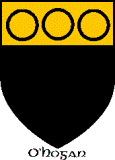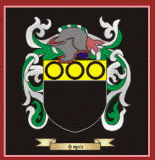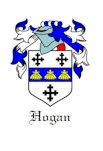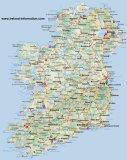

History of the
Hogan, O'Hogan, Ó hOgáin
Surname




Sable on a chief o
Another Crest
Another Crest Map of Ireland
annulets of the field. ireland-information.com
The family gave four bishops to the Diocese of Killaloe, Mathgamin O'hOgain (1268-1281), Mauricius O'hOgain (1282-1298), Tomas O'hOgain (1343-1354), while Richard Hogan, the Franciscan Bishop of Clonmacnoise, was appointed Administrator of the Diocese in 1539. Dermot F. Gleeson, Killaloe Diocesan Historian, has written that "this family name is indeed to be found in the diocesian clergy roll at every stage of its history."
The majority of persons of this name, however, are still to be found in County Clare where the two townlands of Ballogan Mór and Ballyogan Beg, not far from Crusheen, are an indication of their once prominent position in rural society.
Several Hogans are included in the "Dictionary of Irish Biography". Among those who gained an international reputation is John Hogan (1800-1858), an eminent sculptor, who studied and executed classical pieces in Italy and whose splendid works in Ireland include statues of Daniel O'Connell in Limerick and of Father Matthew in Cork.
Another little-known figure who lives on in the folklore tradition of County Limerick was Galloping Hogan, one of the heroes of Patrick Sarsfield's daring exploit which led to the destruction of the Williamite siege train at Ballyneety.
Michael Hogan, another romantic figure, was born in Limerick in 1832 and contributed a good deal of popular verse and stories to the newspapers of his time, including the "Nation". His compositions were later collected and published under the title of "Lays and legends of Thomond", earning for the author the title, Bard of Thomond.
John Baptist Hogan was born in 1829 near Ennis and received a grant to study at Bordeaux. Later he entered the Seminary of St. Sulpice at Issy to begin his novitiate where he was ordained in 1852. There he continued to lecture on theology and other subjects for several years. The Society of Priests of St. Sulpice was founded in 1642 to prepare young men for Holy Orders by training them in the knowledge and virtues required by the dignity of the Sacred Ministry. Later on in life he was transferred to the U.S. as head of St. John's Seminary in Brighton, Massachusetts, before being appointed President of the Divinity College attached to the Catholic University of America in Washington D.C.
In more recent times Patrick Hogan (1886-1969), born in Kilmaley, is best remembered as a successsful Labour politician, a deputy of long standing in Co. Clare and Ceann Comhairle from 1951 to 1969. He presided at the joint meeting of the Dáil and Senate during the official visit in 1963 of President John F. Kennedy. His published works include "The Unmarried Daughter", a collection of short stories; "Camps on the Heartstone", a historical novel and a one-act play, "Roisin's Robe", first performed in 1916 by the Irish Workers' Dramatic Society. He was also the composer of the popular ballad "Shawl of Galway Grey".
Further Reading:
Culligan, Matthew J. "The quest for the Galloping Hogan". New York,
1979.
Hogan, Michael, Bard of Thomond. "Lays and legends of Thomond". Cork,
Fercor, 1973.
This information compiled from ireland.com and other sites.